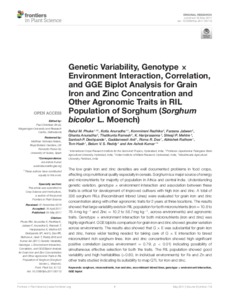Genetic Variability, Genotype × Environment Interaction, Correlation, and GGE Biplot Analysis for Grain Iron and Zinc Concentration and Other Agronomic Traits in RIL Population of Sorghum (Sorghum bicolor L. Moench)
Abstract
The low grain iron and zinc densities are well documented problems in food crops, affecting crop nutritional quality especially in cereals. Sorghum is a major source of energy and micronutrients for majority of population in Africa and central India. Understanding genetic variation, genotype × environment interaction and association between these traits is critical for development of improved cultivars with high iron and zinc. A total of 336 sorghum RILs (Recombinant Inbred Lines) were evaluated for grain iron and zinc concentration along with other agronomic traits for 2 years at three locations. The results showed that large variability exists in RIL population for both micronutrients (Iron = 10.8 to 76.4 mg kg−1 and Zinc = 10.2 to 58.7 mg kg−1, across environments) and agronomic traits. Genotype × environment interaction for both micronutrients (iron and zinc) was highly significant. GGE biplots comparison for grain iron and zinc showed greater variation across environments. The results also showed that G × E was substantial for grain iron and zinc, hence wider testing needed for taking care of G × E interaction to breed micronutrient rich sorghum lines. Iron and zinc concentration showed high significant positive correlation (across environment = 0.79; p 0.60, in individual environments) for Fe and Zn and other traits studied indicating its suitability to map QTL for iron and zinc

